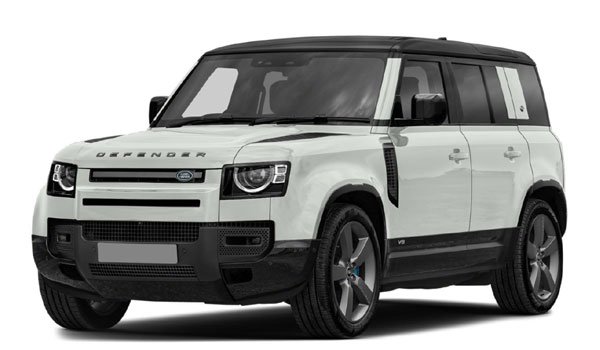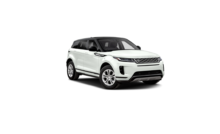2023 Land Rover Defender CLIMATE AND COMFORT Owners Manual








FRONT CLIMATE CONTROL
Do not adjust the touchscreen controls, or allow the system to distract the driver, while the vehicle is moving. Driver distraction can lead to accidents, potentially causing serious injury or death.
To access the front climate screen, select CLIMATE from the Apps screen. See APPS SCREEN.
Alternatively, press the climate button located below the touchscreen (13).
- Touch to select a cabin zone. Cabin zone soft keys vary according to vehicle specification.
- Air distribution to the front windscreen icon: Touch to switch on or off.
- Air distribution to the face icon: Touch to switch on or off.
- Power icon: Touch to switch the climate control system on or off.
- Air distribution to the feet icon: Touch to switch on or off.
- Sync soft key: Select to synchronise the front and rear passenger’s climate settings to the driver’s settings.
- Settings icon: Touch to select the settings screen and then select Climate. See CLIMATE SETTINGS.
- Heated windscreen button: Press to switch on or off. If left on, the heated windscreen deactivates after a timed period, dependent on the ambient temperature. NOTES
In cold ambient conditions, the windscreen and rear screen heaters switch on automatically when the engine is started. The function can be switched on or off via climate settings. See CLIMATE SETTINGS.
NOTES
The heated windscreen operates only when the engine is running. - MAX button: Press to switch maximum defrost for the windscreen on or off.
- Heated rear screen button: Press to switch on or off. If left on, the heated rear screen deactivates after a timed period, dependent on the ambient temperature. CAUTION
Do not attach labels to the rear screen. Do not scrape or use abrasive materials to clean the inside of the rear screen.NOTES
The heated rear screen operates only when the engine is running. - Climate button: Press to access the front climate screen.
- Rotary controls: Rotate to adjust the cabin or seat temperature. Press to switch between cabin temperature control and front seats temperature control. See SEAT TEMPERATURE
- Recirculation button: Press to recirculate air inside the vehicle.
Press briefly to select timed recirculation. Recirculation switches off automatically after a set time, dependent on the ambient temperature.
Press and hold to select latched recirculation. Recirculation remains on until the button is pressed again.
NOTES
Prolonged use may cause the windows to mist. - Blower speed control button: Press to switch blower speed adjustment on or off. Turn the rotary control to adjust the blower speed. NOTES
The blower speed is automatically set in AUTO mode. Adjusting the blower speed cancels AUTO mode. - AUTO mode button: Press to switch fully automatic mode on. Dependent on the vehicle’s specification, the various options for AUTO mode can be set via climate settings. See CLIMATE SETTINGS. NOTES
AUTO mode is the recommended normal operating mode. In AUTO mode, the system regulates cabin climate based on feedback from the vehicle’s sensors, helping maintain a stable and comfortable cabin environment.NOTES
When a climate setting is adjusted manually the system exits full AUTO mode, this overrides automatic climate adjustment and delivers only the selected settings. - A/C button: Press to switch the A/C system on or off. The A/C system can be switched on or off independently of the other climate control functions.
Some of the buttons have an LED indicator lamp that illuminates to confirm selection.
If the climate control system is switched off, pressing the AUTO button or the defrost button switches the climate control system on.
Water expelled by the A/C system may collect underneath the vehicle, when parked. The expelled water is not a cause for concern.
CLIMATE SETTINGS
To view the Climate settings menu, touch the settings icon, then select Climate. See FRONT CLIMATE CONTROL.
- Air purity: The air purity system detects specific harmful gases such as those found in the city traffic. The air purity system controls the automatic recirculation mode to prevent polluted air entering the cabin.
- Auto air flow: The blower speed, for automatic operation, can be set to Soft and Quiet, Balanced, or Powerful and Fast.
- Auto blinds: The auto operation of the roof blind can be enabled or disabled.
- Automatic heated screens: Automatic operation of the heated windscreen and the heated rear screen can be enabled or disabled.
AIR QUALITY
To monitor and adjust the air quality:
- Touch the apps icon on the touchscreen driver side bar. See TOUCHSCREEN HOME MENU.
- Select CLIMATE.
- Select AIR QUALITY.
Air quality menu:
- Purify: When Purify is enabled, the system automatically reduces allergens and particulates at and below 2.5 microns, harmful gases and odours within the cabin. Enabling Purify also activates the air quality sensor system which stops polluted air from entering the cabin.
- CO2: The CO2 management feature ensures CO2 does not build up in the cabin. The CO2 management feature monitors the concentration of carbon dioxide gas in the cabin and selectively opens the recirculation door to let in fresh air to return balance to the cabin air environment. Controlling the CO2 in the cabin reduces the risk of driver drowsiness. The CO2 feature is represented by the white arrows on the vehicle graphic. The white arrows animate when the system is actively balancing the cabin environment.
- Ion: When activated, the Ion feature creates OH radicals to purify the air in-vehicle. The Ion feature is represented by the blue dots on the vehicle graphic.
- Exterior AQI: Launches Air Quality Index (AQI) app. AQI app data is received from an air quality data provider and gives a detailed view of the air quality for the current location. Alternatively the AQI app can display air quality data for a destination that is set in the navigation system or for user-searched locations. NOTES
A data subscription is required to access AQI data.NOTES
The AQI app is not available in all markets.NOTES
The performance of the Exterior AQI feature is dependent on the availability of data from the nearest monitoring station. - Information: Further information about air quality features and capabilities.
- The interior particulate matter concentration. Ranges from green (good) to red (hazardous).
- Exterior air quality as denoted by a colour scale. Ranges from green (good) to red (hazardous)
- Interior air quality as denoted by a colour scale. Ranges from green (good) to red (hazardous)
- The exterior particulate matter concentration. Ranges from green (good) to red (hazardous).
REAR CLIMATE CONTROL
To access the second row climate screen, touch the 2nd Row soft key on the front climate screen. See FRONT CLIMATE CONTROL.
Control the rear climate as follows:
- Cabin zone soft keys: Touch to select a cabin zone. Available cabin zones vary, dependent on vehicle specification.
- Rear panel lock icon: Select to disable the rear climate control switches, in order to prevent the rear passengers from adjusting the rear climate settings. Select again to enable the controls.
- Temperature adjustment arrows: Select the red arrow to increase and the blue arrow to decrease the temperature. The temperature setting is displayed between the arrows.
- AUTO mode: Touch to switch automatic operation on or off.
- Settings icon: Touch to select the settings screen and then select Climate. See CLIMATE SETTINGS.
- Air distribution to the feet icon: Touch to switch on or off.
- Air distribution to the face icon: Touch to switch on or off.
The rear climate can be adjusted with the controls located in the rear of the centre console.
Control the rear climate as follows:
- Cabin and rear seat temperature control: Press to alternate between the two. See SEAT TEMPERATURE.
- Temperature controls: Rotate to adjust the cabin or seat temperature.
- AUTO mode: Press to switch automatic operation on.
- Blower speed controls: Rotate to the adjust blower speed.
- Air distribution to the face button: Press to switch on or off.
- Air distribution to the feet button: Press to switch on or off.
- Sync: The LED illuminates to show that the rear climate controls have been synchronised to the driver’s settings or that the controls are locked.
- Some of the buttons have an LED indicator lamp that illuminates to confirm selection.
- In addition to the selectable controls, the second row climate screen displays symbols that indicate the status of heating and ventilation functions.
- If the climate control system is switched off, pressing the rear AUTO button switches the climate control system on.
- If the system is in defrost mode, all rear controls are disabled and no airflow is available to the rear occupants.
To access the third row climate screen, touch the 3rd Row soft key on the front climate screen. See FRONT CLIMATE CONTROL.
Control the rear chiller from the touchscreen as follows:
- Power icon: Touch to switch the chiller on or off.
- Cabin zone soft keys: Touch to select a cabin zone.
- Blower speed adjustment: Touch to increase or decrease the blower speed.
- Third row chiller lock icon: Touch to lock the third row chiller controls.
The chiller for the third row can also be adjusted using the control at the rear of the vehicle.
The third row chiller provides chilled air through the rear side vents.
Rotate the control to adjust the fan speed.
SEAT TEMPERATURE
Depending on the specification of the vehicle, the seats may have heating and cooling functionality.
Seat heaters consume a large amount of battery power and only operate when the engine is running.
The seat temperature can be adjusted in the following manner:
- Front row seats can be adjusted via the touchscreen and the front rotary controls.
- Second row seats can be adjusted via the touchscreen and the rear rotary controls.
- Third row seats can be adjusted via the heated seat buttons.
To access the seat screen, select SEATS from the Apps screen. See APPS SCREEN.
To adjust the seat temperature via the touchscreen:
- Front or Rear seat selection: Touch to select front or rear seats.
- Temperature adjustment arrows: Touch to increase or decrease the temperature.
- Power icon: Touch to switch the seat heating and cooling on or off.
- Seat zone selection: Touch to select the required seat zone position for heating and cooling.
To adjust the seat temperature via the rotary controls:
- Press to switch between cabin temperature control and seat temperature control.
- Rotate to increase or decrease the seat temperature.
Heated seat icon.
The third row heated seats are operated by the buttons located in the side trim panels.
To operate the third row heated seats:
- Touch the relevant heated seat button to switch the heated seat on at the maximum setting. The three LED indicators in the button illuminate.
- Touch a second time to set the heated seat at the medium setting. Two LED indicators illuminate.
- Touch a third time to set the heated front seat at the lowest setting. One LED indicator illuminates.
- Touch a fourth time to switch off.
AUXILIARY HEATER
Do not operate the auxiliary heater when refuelling the vehicle. Doing so may cause fuel vapours to combust, potentially causing a fire or explosion.
Do not operate the auxiliary heater while the vehicle is in an enclosed space. Doing so can cause a build-up of highly toxic fumes, which may cause unconsciousness or death.
The auxiliary heater is powered by fuel drawn from the vehicle’s tank. The auxiliary heater operates at low ambient temperatures and helps to boost the temperature of the engine’s coolant. Raising the temperature of the engine’s coolant improves cabin heating and engine starting performance. It can also be controlled by the timed climate control system or from the timed climate remote control.
When the auxiliary heater is operating, exhaust fumes from the heater may be visible exiting from under the front of the vehicle. Exhaust fumes from the auxiliary heater are normal and are not a cause for concern.
TIMED CLIMATE
Do not operate the timed climate system when refuelling the vehicle. Doing so may cause fuel vapours to combust, potentially causing a fire or explosion.
Do not operate the timed climate system while the vehicle is in an enclosed space. Doing so can cause a build-up of highly toxic fumes, which may cause unconsciousness or death.
The timed climate system, when in operation, provides a comfortable temperature inside the cabin in advance of using the vehicle. The timed climate system can also maintain a temperature when leaving the vehicle for a short period of time.
The timed climate system draws in fresh air to cool and ventilate the cabin, or operates the auxiliary heater to heat the cabin. Heating or cooling of the cabin is selected by the timed climate system and is dependent on the external temperature.
The timed climate system can be controlled via the touchscreen, or it can be operated using the timed climate remote. The touchscreen control has options for either timed or manual settings.
The timed climate system may not operate, or switches off automatically, in the following scenarios:
- If the fuel level is low.
- If the vehicle’s battery charge is low.
- If the coolant temperature is at, or above, its required temperature.
- If the system has been in operation for 30 minutes.
TIMED CLIMATE TOUCHSCREEN CONTROLS
The touchscreen can be used to either preset activation times or to operate the system manually.
When the system is operating, the LED in the climate control AUTO or Max A/C button flashes. AUTO indicates that the engine or cabin is being heated. Max A/C indicates the that cabin is being ventilated. The choice of operation is automatically determined by the system, depending on the external temperature.
The system ceases operation if the engine is started.
To access the timed climate screen, select VEHICLE DEPARTURES from the apps screen page. See APPS SCREEN.
- Power icon: Touch to switch the timed climate system on or off.
- Current time.
- Settings icon: Touch to select the settings screen. See SYSTEM SETTINGS.
Event icon.
Touch an event icon to switch on, edit, or delete an event.
An event is shown on the timed climate screen even if it is switched off. Make sure that the event is switched on if an event is required.
Touch the timed climate screen to add or edit an event:
- Power icon: Touch to switch the event on or off.
- Repeat every: Touch to enable the event to be repeated on other days.
- Day: Touch to select the days that require the repeated event.
- Hour arrows: Touch to adjust the hour. NOTES
12 or 24 hour clock can be selected via the Time and Date settings. See GENERAL SETTINGS. - Minute arrows: Touch to adjust the minutes.
- Delete icon: Touch to delete the event.
- OK: Touch to set the event.
- Calendar icon: Touch to view the calendar.
- Once only: Touch to select a single event.
The auxiliary heater can be manually operated via the touch screen when the vehicle’s ignition is off.
Manually operate the system as follows:
- Heat now: Touch to heat the cabin and engine via the auxiliary heater. Touch again to turn off.
- Vent now: Touch the circulate air through the cabin. Touch again to turn off.
TEMPERATURE DIFFERENTIATION
The temperatures selected via the climate control system are perceived values. The system operates to achieve these selected values. The selected value does not represent the output temperature from the air vents. Air vent output temperature varies as the system automatically adjusts the vent outputs to achieve the set temperatures.
The actual temperature in the cabin may differ from the set temperatures due to internal and external factors, including ambient temperature, sun load, and direction. The climate control system automatically adjusts the airflow level, direction, and temperature to compensate for these internal and external factors. Automatic adjustments in the air vent outputs may result in some temperature differentiation within the cabin.
Recent Posts
VW Jetta Engine Fuse Box Diagram
Access the comprehensive 2010-2018 VW Jetta Passenger Fuse Box Diagram to troubleshoot electrical issues effectively.…
VW Jetta Passenger Fuse Box Diagram
Explore the comprehensive VW Jetta Passenger Fuse Box Diagram to troubleshoot electrical issues effectively. Understand…
2023 Ford F-150 Lightning Fuse Box Diagram
Under Hood Fuse Box Location Remove the front luggage compartment cover. Under Hood Fuse Box…
2022 Kawasaki NINJA H2 SX SE Brake Lever Adjuster Owner’s Manual
2022 Kawasaki NINJA H2 SX SE Brake Lever Adjuster Owner's Manual NOTICE Only adjust the front…
2023 Land Rover Range Rover Evoque Exiting The Vehicle Owners Manual
2023 Land Rover Range Rover Evoque Exiting The Vehicle SINGLE LOCKING WARNING Before exiting the…
2023 Land Rover Range Rover Evoque Front Seats Owners Manual
2023 Land Rover Range Rover Evoque Front Seats FRONT SEAT SAFETY Make sure to read…
